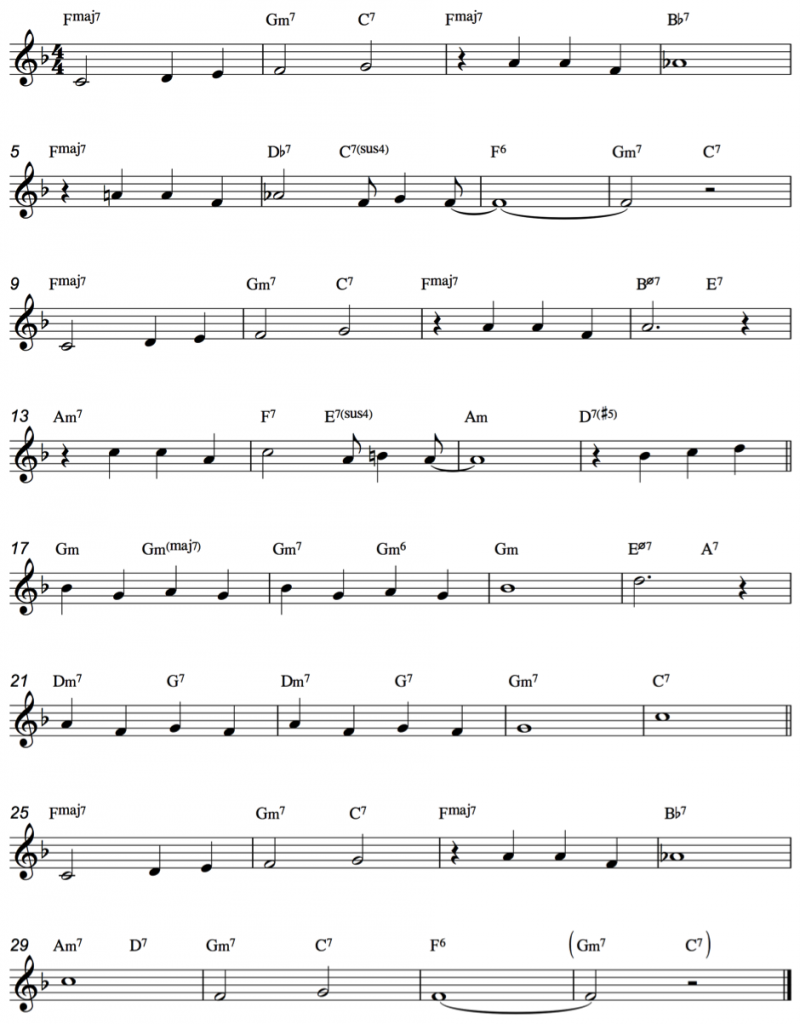Jazz solos
We all want to play more creative jazz solos!
This is the last in the series of extracts from my new book How To Solo: your guide to playing more creative jazz solos.
Click here to purchase my eBook How To Solo and see how your jazz solos improve!
Chapter 11: Interlude from jazz practice
This chapter serves as both an introduction to chapter 12 and an opportunity to take a pause for breath.
During the past 40 years I’ve repeatedly found myself in the following position. I’m in a band or accompanying a singer and about to perform a new song. The bandleader hands me the lead sheet, which I’ve never previously seen.
Although I may not have come across this piece before, I’m nevertheless expected to perform it within the next five minutes. This experience can range from anything between an exhilarating challenge and looking for the nearest exit. The aim of this chapter is to make the experience positive.
Before continuing, you may wish to refer back to book 3, chapters 3, 4 and 5, where I provided you with tools for navigating through jazz standards and chord charts. But now it’s time for a reality check. How would you cope with the above scenario?
Let’s begin by taking a look at how a typical lead sheet might appear in a Real Book. Before studying the lead sheet , imagine that you are in a band or with a singer and have just been handed the music for the first time.
You now have less than two minutes before having to play the tune!
To use this crucial time efficiently, I suggest that you carry out a brief investigation into the following areas:
- Key
- Time signature
- Song structure (form)
- Melodic and rhythmic movement
- Identifiable chord sequences
- Complex chords
For this exercise I’ve chosen ‘Somebody Loves Me’ by George Gershwin.
This chapter serves as both an introduction to chapter 12 and an opportunity to take a pause for breath.
During the past 40 years I’ve repeatedly found myself in the following position. I’m in a band or accompanying a singer and about to perform a new song. The bandleader hands me the lead sheet, which I’ve never previously seen.
Although I may not have come across this piece before, I’m nevertheless expected to perform it within the next five minutes. This experience can range from anything between an exhilarating challenge and looking for the nearest exit. The aim of this chapter is to make the experience positive.
Before continuing, you may wish to refer back to book 3, chapters 3, 4 and 5, where I provided you with tools for navigating through jazz standards and chord charts. But now it’s time for a reality check. How would you cope with the above scenario?
Let’s begin by taking a look at how a typical lead sheet might appear in a Real Book. Before studying the lead sheet (fig 141, below), imagine that you are in a band or with a singer and have just been handed the music for the first time.
You now have less than two minutes before having to play the tune!
To use this crucial time efficiently, I suggest that you carry out a brief investigation into the following areas:
- Key
- Time signature
- Song structure (form)
- Melodic and rhythmic movement
- Identifiable chord sequences
- Complex chords
For this exercise I’ve chosen ‘Somebody Loves Me’ by George Gershwin.
You may feel that my five-point list seems a little excessive for the brief time allotted. However, it’s remarkably simple to speed read much of it:
Key
- One flat indicates either F major or D minor.
- The piece begins with Fmaj7 and ends with II-V-I in F.
We are therefore in F major.
Job done!
Time signature
- 4/4 is stated at the start.
(Sometimes you’ll see the symbol ‘C’ (common time) which means the same thing.
How long has that taken so far? 10 seconds?
Song structure (form)
Some lead sheets do the work for you by marking the copy with letters to indicate sections: A, B, C, etc. The above example doesn’t, so we look for other clues:
- Bar numbers
- Repeat signs
- 1st and 2nd time bars
- Instructions such as DS al coda. (Back to the sign, play through until you reach the coda sign, then jump to the coda).
- Double bar lines.
Apart from bar numbers and double bar lines, none of these clues can be found in our tune. However, the bar numbers provide us with a big clue:
Our tune consists of 32 bars.
————————————————————————————————–
If you now want to improve your jazz solos, click here to purchase my eBook How To Solo.
Click here for my blog.
And if you’re in London you can practise jazz with me!
